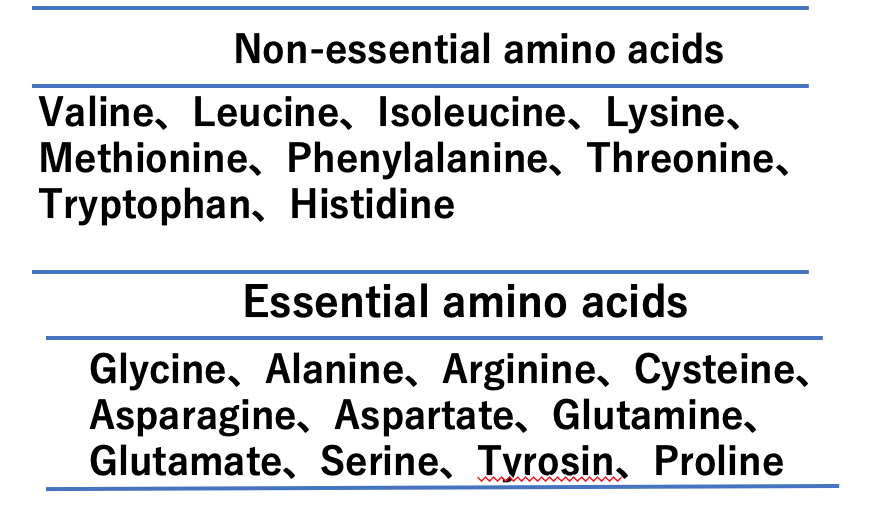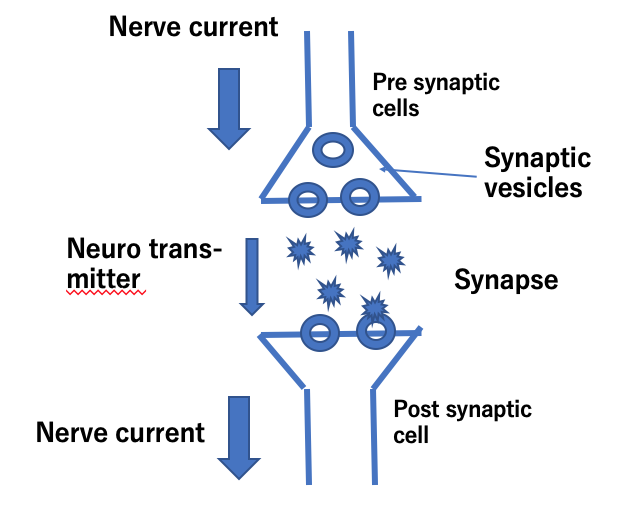
Nutritious food as Medicine
We know well that we need to eat better foods to keep our health. This is known as well as “Nutritious food as Medicine”. Foods are required to keep our health and also important to cure unhealthy conditions as well. The foods for our life are divided into two categories. One is to build our body and the other is for our energy to be active. The former is mainly proteins and amino acids, component molecules of proteins. And the latter are sugars (starch) in rice, bread and noodles, and lipids in the fat of meat. Here, let’s take a look at amino acids as an important resource for our healthy life.
Proteins are made of a combination of 20 amino acids. Those are classified into two independent categories. Those synthesized in our body from other materials are recognized as non-essential amino acids, while those which are needed to be taken up directly from outside of our body, are named essential amino acids. The essential amino acids are taken up by eating meat of fish and animals.

Recently, an interesting subject regarding the non-essential amino acids has been reported in a science journal (Ingested non-essential amino acids recruit brain orexin cells to suppress eating in mice, Viskaits P. et al. Curr. Biol. (2022) Apr. 25, 1812). The authors made such an experiment as non-essential amino acids were introduced artificially into mouse gut which had been starved, while another group of mice were ingested with water or sugar solution as a control. Accordingly, there was an apparent difference in their behavior; mice ingesting the non-essential amino acids began to eat less food, switching their major behavior from eating to exploration. Based on extensive analysis to seek correlation between the behavior and neuronal system, they found that the non-essential amino acids affected neuronal cells which are the target of the hormone, orexin. This hormone is known to control our appetite. The researchers discussed that by the effect of excessive non-essential amino acids after artificial ingestion, the mice decreased eating and then look for nutritionally rich foods. This finding might suggest similarity to our behavior that after we feel full, we look for more delicious things.
In another recent scientific report, correlation of non-essential amino acid tyrosine and behavior of experimental insect, the fly (Sensing of the non-essential amino acid tyrosine governs the response to protein restriction in Drosophila, Kosakamoto, H. et al. Nature Metabolism (2022) 4, p944-p959). Flies were starved and then fed with amino acids rich food like yeast extract. Under this condition, the mice showed less appetite. The results suggested that a non-essential amino acid Tyrosine may controls appetite of the mice under the control by a neuronal system. Two independent recent experimental results described above suggested that the non-essential amino acids within our bodies affect neurons to control our appetite.
While amino acids are the components of proteins, some of those are directly involved in controlling our physiological condition as described above. It is well known that Glutamic acid and Glycine play such roles especially on nerve-control. Accordingly, those are key materials in our body to maintain our mental condition; That is a good example of “Nutritious food as Medicine”.

Here, let’s take a look briefly at how our neuronal system works in our body. Neuron is a kind of an electric wire which transfers a signal to the brain from everywhere within the body and also from our body-surface organs like skin and eyes receiving signals from outside of our body. Within the wire, neuron, the signals are transferred like an electric current. This wire is not a single wire but made of several independent wires connected to each other and a break between two neurons exits, named synapse. At a synapse, the electric current signal is switched to a chemical flow between the two neuronal cells. The chemical signal substance named neuro-transmitters include several amino acids like Glycine and Glutamic acid, and derivatives of amino acids like GABA (Gamma Amino Butylic Acid). When the electric current reaches a neuronal end, synapse, the neuronal substance is released to a space between two neurons (synapse) and then binds to the connected neuron (post synaptic neuron), leading to cause a new electric current in the post synaptic neuron again. Depending on the type of chemical neuro-transmitters, electric current caused in the post synaptic neuron is opposite, i.e. increase or decrease of the original signal. Therefore, intake of some amino acids like Glutamic acid and Glycine may affect signal transmission by neurons. For example, in the case of Glutamic acid as a signal transmitter, the signal is enhanced after the synapse, while Glycine and GABA cause decrease of the signal transmission after a synapse where the neurotransmitter is Glycine or GABA. Glycine is now commercially available to keep good sleep because it may decrease our internal body-temperature by affecting signal transmission in neuronal system, leading to inducing sleep.

At the end of the neuron, the neuron attaches to muscle cells or other organs like the adrenal gland. A neuro-transmitter chemical is again released from the neuron to the muscle cell or adrenal gland cells. When we are upset, adrenalin is released from the adrenal grand which is controlled by a signal from the brain. Adrenalin is synthesized from Tyrosine in our body. Serotonin, another neurotransmitter, is also synthesized from Tryptophan in our body. Decrease of Serotonin release might be involved in mental depression, but the detailed mechanism is not clarified yet.
Here we see amino acids as an example to understand the meaning of “Nutritious food as Medicine”. Now scientific researches are making progress to understand how and where within the brain the signal of starvation switch on the neuronal system by amino acids (The neuronal logic of how internal states control food choice. D. Munch et al. Nature (2022) 607, p747-755).
